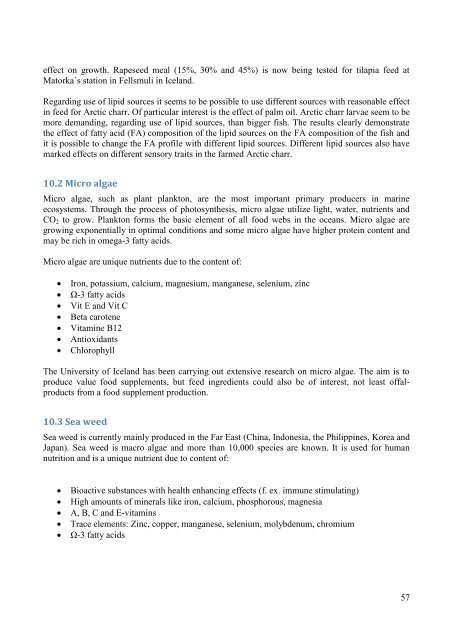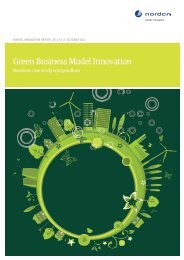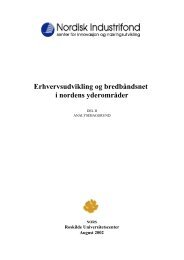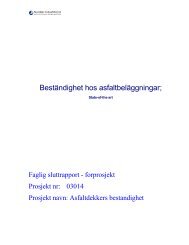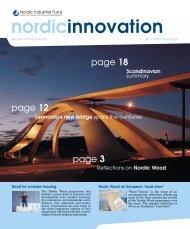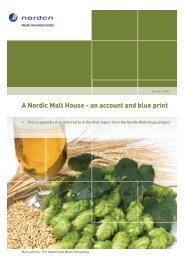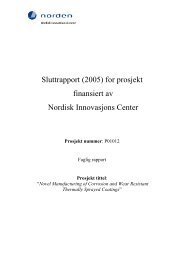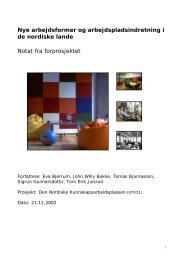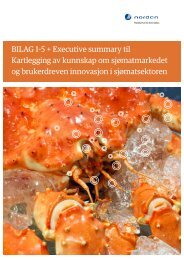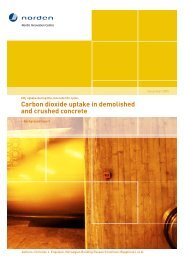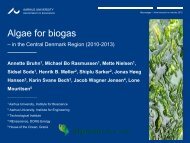Local raw materials for production of fish feed for ... - Nordic Innovation
Local raw materials for production of fish feed for ... - Nordic Innovation
Local raw materials for production of fish feed for ... - Nordic Innovation
You also want an ePaper? Increase the reach of your titles
YUMPU automatically turns print PDFs into web optimized ePapers that Google loves.
effect on growth. Rapeseed meal (15%, 30% and 45%) is now being tested <strong>for</strong> tilapia <strong>feed</strong> at<br />
Matorka´s station in Fellsmuli in Iceland.<br />
Regarding use <strong>of</strong> lipid sources it seems to be possible to use different sources with reasonable effect<br />
in <strong>feed</strong> <strong>for</strong> Arctic charr. Of particular interest is the effect <strong>of</strong> palm oil. Arctic charr larvae seem to be<br />
more demanding, regarding use <strong>of</strong> lipid sources, than bigger <strong>fish</strong>. The results clearly demonstrate<br />
the effect <strong>of</strong> fatty acid (FA) composition <strong>of</strong> the lipid sources on the FA composition <strong>of</strong> the <strong>fish</strong> and<br />
it is possible to change the FA pr<strong>of</strong>ile with different lipid sources. Different lipid sources also have<br />
marked effects on different sensory traits in the farmed Arctic charr.<br />
10.2 Micro algae<br />
Micro algae, such as plant plankton, are the most important primary producers in marine<br />
ecosystems. Through the process <strong>of</strong> photosynthesis, micro algae utilize light, water, nutrients and<br />
CO2 to grow. Plankton <strong>for</strong>ms the basic element <strong>of</strong> all food webs in the oceans. Micro algae are<br />
growing exponentially in optimal conditions and some micro algae have higher protein content and<br />
may be rich in omega-3 fatty acids.<br />
Micro algae are unique nutrients due to the content <strong>of</strong>:<br />
Iron, potassium, calcium, magnesium, manganese, selenium, zinc<br />
Ω-3 fatty acids<br />
Vit E and Vit C<br />
Beta carotene<br />
Vitamine B12<br />
Antioxidants<br />
Chlorophyll<br />
The University <strong>of</strong> Iceland has been carrying out extensive research on micro algae. The aim is to<br />
produce value food supplements, but <strong>feed</strong> ingredients could also be <strong>of</strong> interest, not least <strong>of</strong>falproducts<br />
from a food supplement <strong>production</strong>.<br />
10.3 Sea weed<br />
Sea weed is currently mainly produced in the Far East (China, Indonesia, the Philippines, Korea and<br />
Japan). Sea weed is macro algae and more than 10,000 species are known. It is used <strong>for</strong> human<br />
nutrition and is a unique nutrient due to content <strong>of</strong>:<br />
Bioactive substances with health enhancing effects (f. ex. immune stimulating)<br />
High amounts <strong>of</strong> minerals like iron, calcium, phosphorous, magnesia<br />
A, B, C and E-vitamins<br />
Trace elements: Zinc, copper, manganese, selenium, molybdenum, chromium<br />
Ω-3 fatty acids<br />
57


